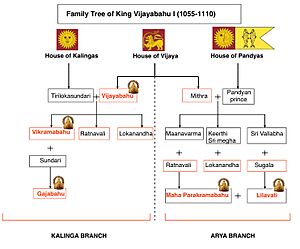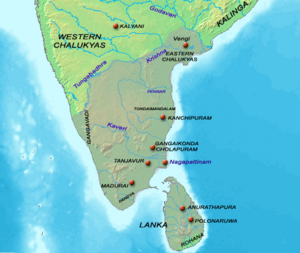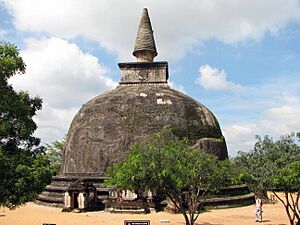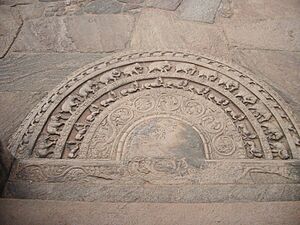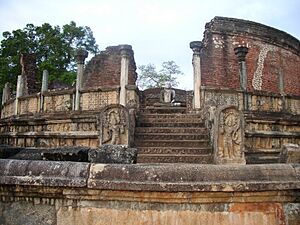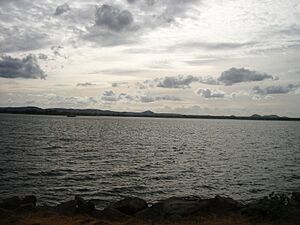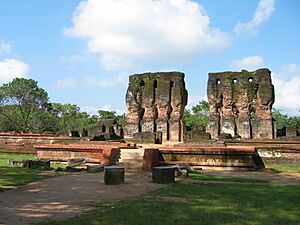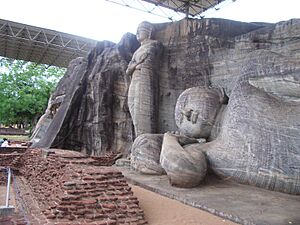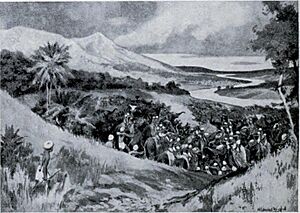Parakramabahu I facts for kids
Quick facts for kids Parākramabāhu the Great |
|||||
|---|---|---|---|---|---|
| King of Polonnaruwa | |||||
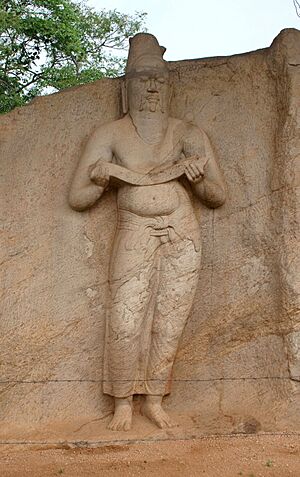
The statue in Polonnaruwa traditionally held to be of Parākramabāhu the Great
|
|||||
| Reign | 1153–1186 | ||||
| Coronation | 1153 | ||||
| Predecessor | Manabharana of Ruhuna | ||||
| Successor | Vijayabâhu II | ||||
| Born | 1123 Punkhagama, Dakkhinadesa |
||||
| Died | 1186 (aged 62–63) Polonnaruwa |
||||
| Spouse | Queen Lilavati
Queen Rupawathi Queen Subhadra |
||||
|
|||||
| House | House of Vijayabahu | ||||
| Dynasty | Arya | ||||
| Father | Prince Manabharana of Dakkhinadesa | ||||
| Mother | Princess Ratnavali | ||||
| Religion | Theravada Buddhism | ||||
Parākramabāhu I (born around 1123, died 1186), also known as Parakramabahu the Great, was a powerful king of Polonnaruwa in Sri Lanka. He ruled from 1153 to 1186. During his time, he made his capital city, Polonnaruwa, bigger and more beautiful. He also built many large water systems, like canals and reservoirs, to help farmers.
King Parakramabahu was a strong leader. He improved the country's army and brought changes to Buddhist practices. He also supported arts and led military campaigns in South India and Burma. One of his most famous sayings was: "Not even a drop of water that comes from the rain must flow into the ocean without being made useful to man." This shows how much he valued water and its use for his people.
In 1140, Parakramabahu became the ruler of a region called Dakkhinadesa. Over the next ten years, he made many improvements there. After a long civil war, he gained control over the entire island of Sri Lanka around 1153. He remained king until his death in 1186. During his reign, he also helped the Pandyan dynasty in southern India against the Chola dynasty. He also had important trade connections with countries like China and those in the Middle East.
Within Sri Lanka, he built and repaired many religious buildings and hospitals. He also created social welfare centers, canals, and huge reservoirs, such as the famous Sea of Parakrama.
Contents
Early Life of Parākramabāhu
A Divided Island
For a long time, the island of Sri Lanka faced challenges from invaders, especially the Cholas from South India. They took over a large part of the island. It wasn't until Vijayabahu I (1070–1100) successfully drove them out that the island became free again. Vijayabahu I decided to keep Polonnaruwa as the capital instead of returning to the older city of Anuradhapura.
By the time Vikramabāhu I (1111–1132) was king, Sri Lanka was divided into three main kingdoms. These were the Kingdom of Rajarata, Kingdom of Dakkhinadesa, and Kingdom of Ruhuna. King Vikramabāhu I ruled Rajarata, which was considered the most important because it had many religious and historical sites.
However, there were other powerful leaders. Manabharana, the king of Dakkhinadesa, and his brothers, Sri Vallabha and Kitti Sri Megha, who ruled Ruhuna together, were strong rivals. They were all descendants of Vijayabahu I's sister, which gave them a strong claim to the throne. They were known as the Arya branch of the royal family, while Vikramabāhu I was from the Kalinga branch.
His Birth and Childhood
Parākramabāhu was born around 1123 in Punkhagama, the capital of Dakkhinadesa. His father was Manabharana, the governor of Dakkhinadesa. At the time, Manabharana was worried because he only had daughters and no sons to continue his family line.
The ancient stories say that Parākramabāhu's birth was predicted in a dream by his father. When he was born, he was named Parakramabahu. King Vikramabāhu I in Polonnaruwa heard about the child and wanted him to be raised as his heir. This might have been a way to keep peace between the two royal families.
However, Manabharana refused, saying his son was too precious to send away. Soon after Parākramabāhu's birth, Manabharana became ill and died. Parākramabāhu, his mother Ratnavali, and his two sisters then moved to Ruhuna to live with his uncle Sri Vallabha.
Youth and Rise to Power
Life in Ruhuna and Dakkhinadesa
While Parākramabāhu was still young, his older sister Mitta was forced to marry their cousin, Manabharana of Ruhuna. This was against the wishes of their mother, Queen Ratnavali. During his time at Sri Vallabha's court, Parākramabāhu met Lilavati, Sri Vallabha's daughter, who would later become his queen. Lilavati herself would rule Sri Lanka three times after Parākramabāhu's death.
In 1132, King Vikramabāhu I died, and his son, Gajabahu II, became the king of Rajarata. Sri Vallabha and Kitti Sri Megha, from the Arya branch, tried to take over Rajarata but failed.
Parākramabāhu, feeling impatient with his small role, left Ruhuna and returned to Dakkhinadesa. His uncle Kitti Sri Megha welcomed him warmly, as he had no sons of his own. Parākramabāhu was essentially adopted by his uncle.
Journey to Rajarata
Later, Parākramabāhu secretly left Dakkhinadesa and went to Gajabahu II's kingdom in Rajarata. He met with allies and even had one of Gajabahu's generals killed when the general tried to tell Kitti Sri Megha about his journey. Parākramabāhu then took control of some areas and continued his journey to Gajabahu's court.
While in Gajabahu's court, Parākramabāhu did two important things. First, he used spies to gather information about Gajabahu's court. Second, he arranged for one of his sisters, Bhaddavati, to marry King Gajabahu. This marriage helped Parākramabāhu gain Gajabahu's trust. However, Parākramabāhu kept all of his sister's wedding gifts for himself.
Eventually, Gajabahu became suspicious of Parākramabāhu. Realizing this, Parākramabāhu secretly left Rajarata at night and returned to Dakkhinadesa.
Becoming King of Dakkhinadesa
Back in Dakkhinadesa, Parākramabāhu was hesitant to see his uncle, King Kitti Sri Megha. But his mother, Ratnavali, convinced him to go. Soon after Parākramabāhu's return, Kitti Sri Megha died. The ancient texts note that Parākramabāhu did not show much sadness, perhaps because of past disagreements. Parākramabāhu then became the king of Dakkhinadesa.
King of Dakkhinadesa
Building and Government
By 1140, Parākramabāhu was the sole king of Dakkhinadesa. His goal was to make his kingdom greater than the other two. He set up a new administrative center called Parakramapura, which is believed to be the modern city of Panduwas Nuwara.
He then began a massive project to build and repair temples and other structures. Many of these can still be seen in Sri Lanka today. He even restored an ancient causeway over the Deduru Oya. When his architects said a project was almost impossible, Parākramabāhu famously replied, "What is there in the world that cannot be carried out by people of energy?"
He ordered the building of many canals and dams. He also cleared large areas of forest to create new rice fields. Most famously, he built the Parakrama Samudra, a huge reservoir that provided water to a vast area. He even built a palace and a stupa (a Buddhist shrine) on islands in the middle of this reservoir.
Trade and War Preparations
Trade was very important for Dakkhinadesa. Sri Lanka's location made it a key point on many major trade routes. Chinese silk was imported, and pearls, gems, cinnamon, and war elephants were exported. Most trade happened through the main seaports like Kalpitiya and Colombo.
Parākramabāhu decided to expand his kingdom through war. He first focused on reorganizing and strengthening the army of Dakkhinadesa. His army included different groups of people, even those not usually involved in fighting. The ancient texts say his army had about 100,000 soldiers, but the real number was probably smaller. He had war elephants, cavalry, and siege engines, making his army a serious threat.
Conquering Rajarata
War with Gajabahu
Around 1150, Parākramabāhu began his expansion. He first took control of Malaya, securing his eastern side. Then, he moved his forces against leaders on the border of Rajarata. After defeating an army of King Gajabahu, there was a short ceasefire.
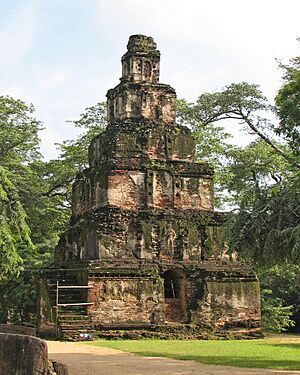
Hostilities soon started again. Gajabahu sought help from other countries. Parākramabāhu himself didn't lead the invasion of Rajarata, but he planned the entire strategy. His forces captured areas along the western coast and sailed north. Gajabahu's general, Gokanna, suffered several defeats and had to retreat.
Dakkhinadesa's troops advanced and captured Rajarata, taking King Gajabahu prisoner in his palace. Parākramabāhu ordered his soldiers to treat Gajabahu with respect and not to loot the city.
However, some soldiers ignored his orders and plundered homes. This angered Gajabahu, who then asked Manabharana of Ruhuna for help.
War with Manabharana
Manabharana of Ruhuna attacked Parākramabāhu's forces and drove them out of Polonnaruwa. But Manabharana then turned against Gajabahu, imprisoning him and letting him starve.
Gajabahu secretly sent a message to Parākramabāhu, asking for help. Parākramabāhu ordered his troops to cut off food supplies to Manabharana's areas. This made Manabharana's people weak. When Manabharana left Polonnaruwa to fight another force, Parākramabāhu's army seized the city, freed Gajabahu, and took Manabharana's treasures. Manabharana returned to Ruhuna with important sacred relics, like the Tooth Relic.
Gajabahu, now free, decided to leave the country. But some of his followers attacked Parākramabāhu's troops, restarting the conflict. Parākramabāhu had to send his army to capture Gajabahu. By late 1153, Gajabahu realized he would be captured and asked the Buddhist monks (Sangha) to step in. They convinced Parākramabāhu to let the ailing king live in peace. Gajabahu then officially gave up his throne to Parākramabāhu. He moved to Gantale, where he died.
Coronation and Final Victory
Parākramabāhu was crowned king of Rajarata, but the war wasn't over. Manabharana attacked again from Ruhuna. Parākramabāhu decided to defeat Manabharana once and for all. He sent his general Rakkha to hold off Manabharana's forces while he attacked Ruhuna directly.
Manabharana, supported by his people, managed to push back Parākramabāhu's army and even recaptured Polonnaruwa. Both sides were exhausted from years of fighting. Eventually, Manabharana fled the city for Ruhuna. His forces were defeated, and Manabharana himself died from illness and exhaustion.
Finally, Parākramabāhu became the undisputed ruler of the entire island of Sri Lanka. This victory came after about five years of continuous warfare. He celebrated by making peace with Manabharana's son and holding a grand coronation ceremony.
| Timeline of Parākramabāhu's rise to the throne | ||||||||||||||||||||||||||||||||||||||||||||||||
| Kingdom | Monarch | |||||||||||||||||||||||||||||||||||||||||||||||
| 1090 | 1100 | 1110 | 1120 | 1130 | 1140 | 1150 | 1160 | 1170 | 1180 | |||||||||||||||||||||||||||||||||||||||
| Rajarata | Vikramabāhu I | Gajabāhu II | ||||||||||||||||||||||||||||||||||||||||||||||
| Dakkhinadesa | Vijayabāhu I | Manabharana | Kitti Sri Megha | Parākramabāhu I | ||||||||||||||||||||||||||||||||||||||||||||
| Ruhuna | Sri Vallabha & Kitti Sri Megha | Sri Vallabha | Manabharana | |||||||||||||||||||||||||||||||||||||||||||||
King of All Sri Lanka
Parākramabāhu settled in Polonnaruwa from 1153 and ruled over all of Sri Lanka for the next 33 years. During this time, he carried out many of the great works he is remembered for, especially in religious changes, construction, and military campaigns.
Economic Policies
Parākramabāhu believed that the government should control most trade, similar to what we might call state capitalism today. This meant that the government managed most of the buying and selling of goods. There were also taxes collected from the people.
Religious Changes
For a long time, the Buddhist monks (Sangha) in Sri Lanka were divided into three main groups. One of Parākramabāhu's main goals was to unite these groups into one, just as they had been in earlier times. He also felt that many monks had become too focused on worldly things, like getting married or making money.
Around 1165, a meeting of Buddhist leaders was held in Polonnaruwa to discuss changes to the Sangha. Parākramabāhu worked closely with a wise monk named Mahathera Kassapa. There was a lot of resistance to Parākramabāhu's ideas, especially from groups that followed different forms of Buddhism. Many monks left the country or stopped being monks rather than follow the new rules. Parākramabāhu seemed to encourage this, believing that getting rid of those who didn't follow the main teachings would make the Buddhist order stronger.
After these changes, the king would meet with the leaders of the Sangha once a year. This helped him keep track of their progress and standards. Following Parakramabahu's efforts, the main form of Buddhism, Hinayana (Theravada), became very strong in Sri Lanka again.
After putting down rebellions in Ruhuna in 1157, Parākramabāhu brought the sacred Tooth Relic and alms bowls to Polonnaruwa. He placed these important items in a shrine called the Temple of the Tooth Relic.
Great Construction Projects
Parākramabāhu's building projects are a huge part of Sri Lanka's history. Many of the ancient ruins you see in Polonnaruwa today are from his time. One of his first projects was to restore the ancient city of Anuradhapura, including temples like Thuparamaya and Ruwanwelisaya.
He then focused on Polonnaruwa. The city had been damaged by many sieges, so he rebuilt and expanded it. He divided the city into four districts, each with a place for giving food to the monks. He also ordered the building of hospitals, which he visited often.
Parākramabāhu also made Polonnaruwa's defensive walls stronger, building a complex system with three walls and fourteen gates. Although these walls haven't survived, they show the grand scale of his plans. He also created beautiful gardens around Polonnaruwa, with ponds and bathing pools. The famous Twin Pools still exist today.
Many other structures from his reign still stand, like the Gal Vihare, or "Stone Shrine," near Polonnaruwa. This site features three large Buddha statues carved from a single rock. The Polonnaruwa Vatedage, a beautiful circular shrine, was built around 1157, likely to hold the Tooth Relic. The Lankatilaka Temple and the Demala Maha Cetiya were also built during his rule. He expanded and beautified the royal palace in Polonnaruwa, though little of it remains today.
Parākramabāhu continued his work on water systems, repairing and rebuilding reservoirs and canals that were damaged during earlier invasions. He built the massive Parakrama Samudra, which covers about 2,400 hectares (almost 6,000 acres) of water. Inscriptions found at other reservoirs, like the Maha Wewa and Padavi Wewa, mention his work. One inscription says, "Made for the benefit of the whole world by the prosperous Sri Parakrama-Bahu."
It is said that Parākramabāhu restored or built over 165 large reservoirs, along with thousands of smaller ones and canals. However, these huge projects came at a cost. They were very expensive and required a lot of work from the people. He used Tamil prisoners of war from the Pandyan War to help repair buildings damaged by the Chola invasion. Taxes were high, and people also had to provide free labor to the king, a system called rajakariya.
Military Campaigns
Parākramabāhu's reign is known for two major military campaigns: one in South India and another against the kings of Ramañña (Lower Burma). He also had to put down several rebellions in Ruhuna.
Rebellions in Ruhuna
In 1156, Queen Sugala of Ruhuna, the mother of Manabharana (who had fought Parākramabāhu for the throne), joined a revolt against the king. The situation became serious when mercenaries took advantage of the absence of Parākramabāhu's army and revolted in 1157. This rebellion was organized by the army of Ruhuna.
Parākramabāhu sent his generals to deal with the conflict in Ruhuna. The fighting was tough and lasted a long time. One important victory for the king was the capture of the Sacred Relics in late 1157.
The tide turned when more soldiers arrived in Ruhuna around 1158. The city of Mahagama was captured, and Queen Sugala was taken prisoner. Parākramabāhu's forces then dealt harshly with the people of Ruhuna, likely because the king was tired of their constant opposition. This harsh suppression ensured that Ruhuna remained peaceful for the rest of his reign, except for a small uprising in 1160. What happened to Queen Sugala is not known.
Another small rebellion happened in the Mantota region from 1168 to 1169.
War with Bagan (Burma)
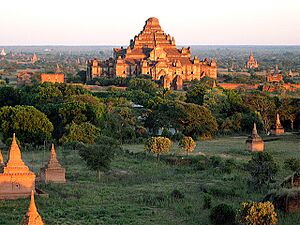
The kingdom of Bagan (modern Burma) and Sri Lanka had been friendly for a long time. They traded and shared the same Buddhist faith. However, when Narathu became king of Bagan (1167–1171), things changed. He treated Sri Lankan envoys badly, stopped selling elephants to foreign countries, and even imprisoned and tortured Sri Lankan messengers. He also confiscated their possessions.
Narathu reportedly told the Sri Lankan envoys that no more ships from Sri Lanka should come to his kingdom. He even demanded a written statement that if he killed future envoys, no one would blame him.
Parākramabāhu was furious. He prepared a strong navy at Pallavavanka and sent it to Bagan. The size of the army is unknown, but it carried a year's supply of food, special arrows, and Sri Lanka's famous war elephants. Despite some ships sinking, the army reached the city of Kusima (modern Pathein) and captured it. The ancient texts say they captured other cities, including Narathu's capital, killed Narathu, and restored good relations between the two countries.
While the story of this invasion might be exaggerated in Sri Lankan records, there is evidence that some kind of successful campaign took place. Burmese stories also mention a Sri Lankan invasion that removed Narathu from power. An inscription from that time mentions a general being rewarded for his leadership in a campaign to 'Ramanna' (Burma).
Pandya War (1169–1177)
In 1167, the Pandyan king Parakrama asked Parākramabāhu of Sri Lanka for help. He was fighting against his rival Kulasekhara Pandya and the Chola dynasty. It was common for Pandyan kings to seek help from Sri Lankan monarchs, especially against the Cholas.
However, Sri Lankan help came too late. By the time Parākramabāhu's general Lankapura Dandanatha arrived in Pandya Nadu, Kulasekhara had captured the capital city of Madurai and killed King Parakrama's wife and children. Parakrama's son, Prince Virapandu, managed to escape.
Instead of going straight to Madurai, Lankapura landed near Ramanathapuram and captured Rameswaram. This area remained under Sri Lankan control for some time. They built a fortress there called Parakramapura. Lankapura's army fought Kulasekhara several times, eventually besieging Madurai and capturing the city. Prince Virapandu was put back on the throne as the Pandyan King. Lankapura's army stayed in Madurai and continued to fight the Cholas across South India.
Kulasekhara Pandya later got help from the Cholas and fought Lankapura's army again. But Lankapura defeated them once more. He even ordered that Sri Lankan money be used in the areas he controlled. Tamil prisoners of war captured by Lankapura's army were sent to Sri Lanka to help repair buildings damaged by earlier Chola invasions.
Ancient Sri Lankan sources say that Lankapura returned to Sri Lanka as a great war hero and was rewarded by Parākramabāhu I. However, Chola inscriptions tell a different story. They say that the Chola king ordered his commander to kill Lankapura and other Sri Lankan generals and hang their heads at the gates of Madurai. This suggests that the war ended with the Cholas winning.
Later, the Cholas also supported Sri Vallabha, Parākramabāhu's nephew and a rival for the throne of Polonnaruwa. Sri Vallabha stayed with the Chola army and helped them. The Cholas sent an expedition to Sri Lanka, destroying several places where Parākramabāhu was gathering his forces. They captured elephants and burned a large area, killing or capturing some Sri Lankan leaders.
According to some historians, Parakramabahu later tried to trick Kulasekhara into invading the Chola Kingdom by sending him expensive gifts. Kulasekhara invaded but was defeated. Chola forces then successfully invaded the Pandya kingdom and put Prince Vira Pandya back on the throne.
Death and Legacy
Succession
The ancient texts say that Parākramabāhu ruled for 33 years and died in Polonnaruwa. He was succeeded by Vijayabahu II of Polonnaruwa, who was his sister's son. Vijayabahu II brought back friendly relations with the kingdom of Ramañña (Burma), which Parākramabāhu had fought against.
Historians note that Parākramabāhu did not make clear plans for who would rule after him. This led to instability and civil war after his death, which undid many of his great building projects. Polonnaruwa itself was eventually lost to the jungle and only rediscovered much later.
His Impact
Parākramabāhu's influence was huge. The fact that seven later kings took his name shows how popular and respected he was. The Sri Lankan Navy even has two ships named after him.
His massive building projects, like the Parakrama Samudra and the impressive ruins in Polonnaruwa, can still be seen today. These show the grand scale of his vision. However, all this success came at a price. The constant wars and huge construction projects put a heavy burden on the country and its people. Taxes were high, and there were signs of increasing poverty towards the end of his rule.
His main weakness was his huge spending, which, while it brought Sri Lanka to new heights, also exhausted the island's resources.
See also
- Mahavamsa
- List of monarchs of Sri Lanka
- History of Sri Lanka
- Architecture of ancient Sri Lanka


